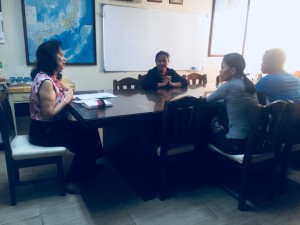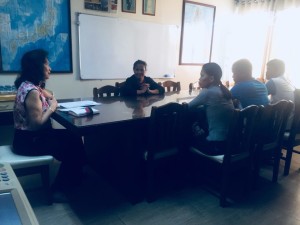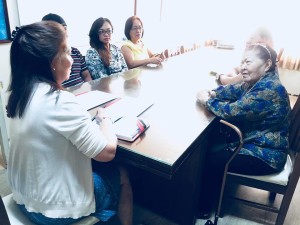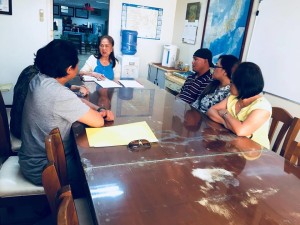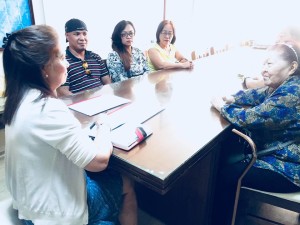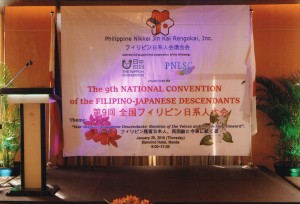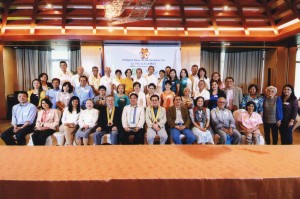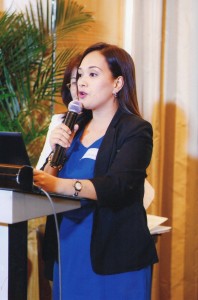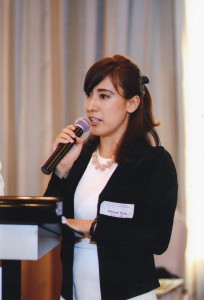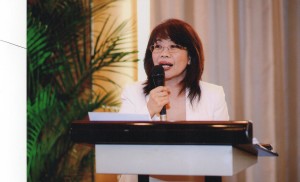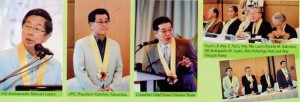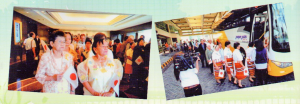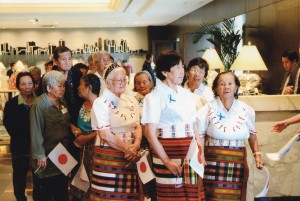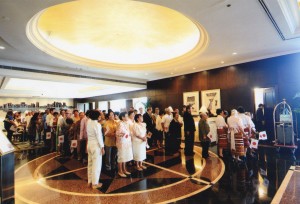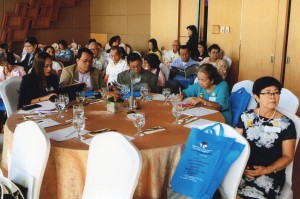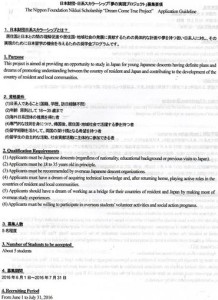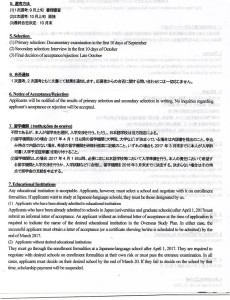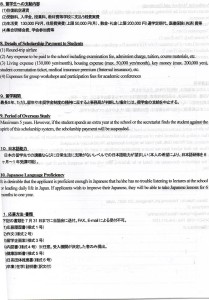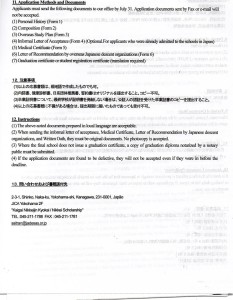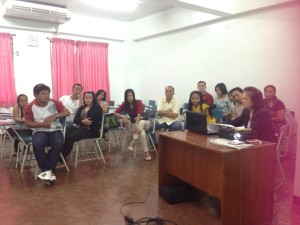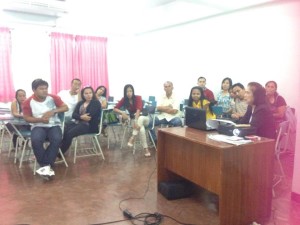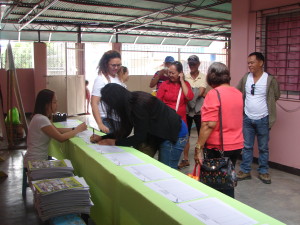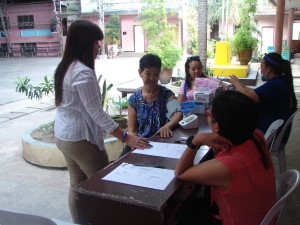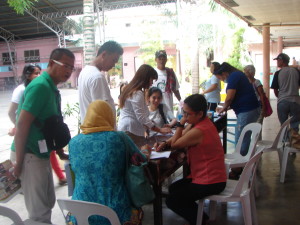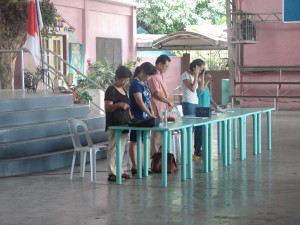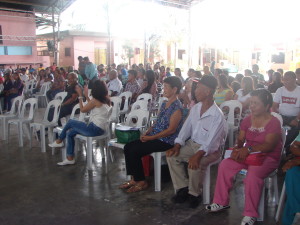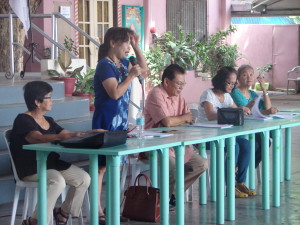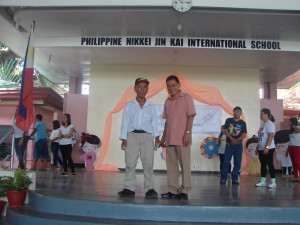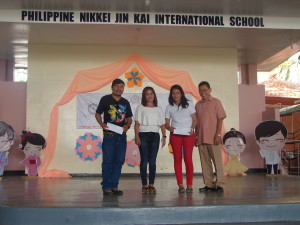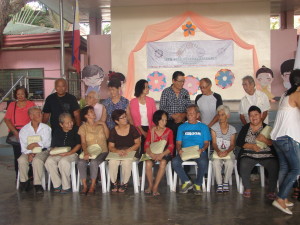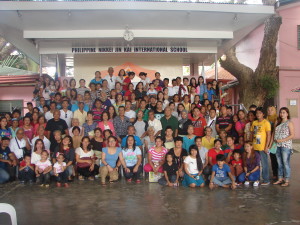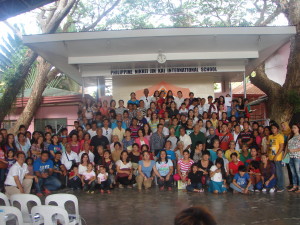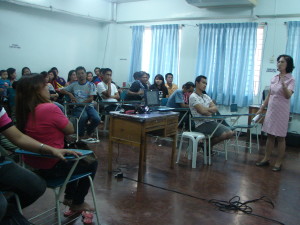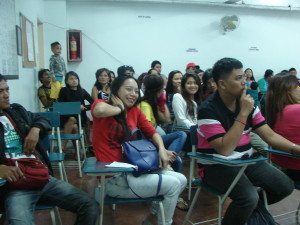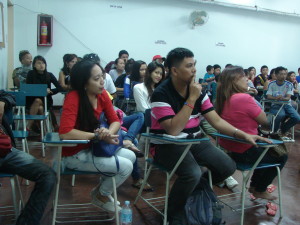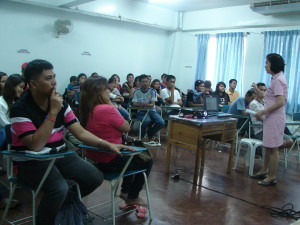Tag: Descendants
“9th National Convention held on January 28, 2016 at the Diamond Hotel, Manila”
The activities on said date were divided into three (3) parts to wit:
Davao Delegates during 9th National Convention
Part I
From 9:00 a.m. to 9:45 in the morning registration of participants started, followed by a break from 9:45 a.m. to 10:00 a.m. Five participants namely: Mr. Carlos Teraoka, his wife, Mrs. Ines P. Mallari with her husband, the Rengokai Secretary, Mr. Benedicto Onari and Mr. Lemuel Yoshimura with his wife were ushered to a van that will conduct them to Sofitel where a separate room has been designated for their group including Japanese businessmen in the Philippines chosen by the Embassy of Japan in Manila to have a brief dialogue with Their Majesties The Emperor and Empress. A bus was assigned to the Nisei or the 2nd generation to take them for Sofitel Hotel where they will meet their Majesties after the latter’s brief dialogue with the group of thirty-five. All Nisei were holding flaglets as their gesture of welcoming Their Majesties
Part II – Special Sessions: 10:00am to 12:00 Noon
A. Workshop Sessions for the rest of the attendees with the following topics: Citizenship and Immigration Matters concerning Filipino Nikkeijins facilitated by Mrs. Melissa Roales, President, Cotabato Nikkei Jin Kai chapter.
B. The Role and Future of Nikkeijins in the Society, 70th Year after the war, and 60th Year after the Restoration of the Bilateral Relations between Japan and Philippines facilitated by Mrs. Noelyn Fernandez, Board Member, PNJK Davao Chapter.
During lunch time there was an audio visual presentation about the history of Filipino Nikkeijin.
Part III – Program Proper
With the song amazing grace as a background, the invocation was led by Ret. Judge Antonina B. Escovilla, Rengokai Secretary and President, PNJK Davao Chapter.
Thereafter, the emcees – Ms. Eve Obuchi and Ms. Hitomi Kita introduced the guests and the presentation of delegates by chapter.
Mrs. Ines P. Mallari delivered her welcome address and followed by Dr. Shun Ohno’s talk about the Filipino Nikkeijin. He is currently a Professor of the Seisen University.
While Chairman of the Nippon Foundation Mr. Yohei Sasakawa was not in attendance, he however sent his congratulatory greetings read by our Emcees.
Atty. Hiroyuki Kawai the Chairman, Philippine Nikkeijin Legal Support Center updated us with the “shuseki” proceedings as well as extending his congratulatory greetings. According to the introduction, Atty. Kawai is not only a Noh dancer but a good singer as well and expert in bike riding. Atty. Kawai mentioned the proceedings with the Family Court of Domestic Relations with 165 petitions given favorable action while about 120 has not as yet been given due course. He is hoping that the Japanese government will be so kind in giving the recognition to those who are stateless.
Hon. Susumu Tsuda, First Secretary and Consul of the Embassy of Japan based in Manila delivered the keynote address in Nihongo and interpreted by Ms. Eve Obuchi.
An intermission number was rendered by a group of young descendants from Manila both in Nihongo and English.
His Excellency Ambassador Manuel M. Lopez, Philippine Ambassador to Japan, Embassy of the Republic of the Philippines, took time in coming to Manila to deliver his congratulatory message. It was so kind of him to be with us during such big event despite his heavy schedule in Japan.
The organizing committee invited Atty. Ma. Laarni Rycelle M. Gabriana from the Bureau of Immigration to shed light on some concerns involving the descendants. She cited Commonwealth Act No. 613 otherwise known as the Philippine Immigration Act of 1940. This is the same law which her office has been implementing as far as some of us are involved.
Mr. Yoshihiro Tokumitsu the President of the Japan Philippine Industry Council (JPIC) congratulated the Rengokai officers for a job well done. His group has been supporting the descendants and will continue to do so by reason of the bilateral relations between Japan and the Philippines. A number of descendants have been deployed in Japan and some are performing well in their assigned tasks.
Ms. Melissa Roales presented the output of their workshop and these are the following:
Workshop Outputs
Citizenship and immigration concerns
Nisei – kosekis of many are still to be located; difficulty in producing documents to prove citizenship
– Urgency to reacquire Japanese citizenship because they are aging, average age is mid-70s;
Nisei – too old to start a new life in Japan; many who had reacquired citizenship opt to live in the Philippines but need permission to stay in the Philippines.
Sansei – for those whose Japanese (Nisei) parent has not yet been located and had passed away, they lose the chance of being recognized as Japanese descendants.
Sansei – those who have left for Japan, some are not socially ready thus are undergoing difficulty in adjusting to a new culture; not proficient in Japanese language
Sansei – for those who have returned to the Philippines there is a danger of losing Japanese permanent residency; they want to be mobile;
Yonsei – if Nisei is not upgraded, they lose the chance to live in Japan when they are over 18 years old.
Recommendation:
- Request proper authorities to hasten recognition of Japanese descendants especially the aging Niseis
- To request proper authorities to address Philippine residency status of Niseis granted with Japanese citizenship
- Guidance on how to process documents for visa application after koseki is located
- Orientation on the implications of having Japanese passport and chooses to live in the Philippines; and steps to get permission to stay in the Philippines;
- Orientation to prepare NikkeiJins leaving for Japan regarding Japanese Culture as well as visa renewal. Re-entry permits, application for permanent residency.
OUTPUTS FROM THE GROUP OF MRS. NOELLYNE FERNANDEZ:
- Continue tracing the family’s heritage, roots and bloodline for those who have not yet recognized their ascendants;
- Offer assistance to other nikkeijins with their problems relative to documents with regard to the legal identity, help in processing the documents of those Nikkeijins who lost their family registry during the war;
- For the younger generations, education and leadership trainings is of the essence;
- Educate the next generation of Nikkeijins and change the mindset of the future Nikkeijins to venture into something that is productive and that is of long term most especially to our less fortunate Nikkeijins;
- Acquire higher education and help the society through their skills and professions;
- Preserve the good image of Japanese heritage and the positive likeness of a Nikkeijin;
- Assist the elderly Nikkeijins especially with medical services;
- Strengthen the relationship among Nikkeijin all over the Philippines and those who are in Japan;
- For the Nikkeijins to satisfactorily perform their roles and responsibilities, support system and assistance is a great contributing factor.
OPEN FORUM:
There were questions raised but due to time constraint only three were entertained, to wit:
- Consuelo Susumoto from Manila Nippi – holder of two passports – Japanese and Philippine Passport. Can she hold both? She was born in 1943. Atty. Sim Zuniega answered her that she has to choose which of the two nationalities she wants to retain because she is covered by the 1935 Philippine Constitution. Under the present law, there is no problem. But in her case she can only choose one. Atty. Locano likewise rendered his opinion.
- Jose Tai from Manila Nippi – His question has something to do with certain fee when one applies for work as this was what Aida del Pilar told him. Mr. Buñi informed him that Ms. Del Pilar is not anymore with Manila Nippi. It would be best for him to see the office of Manila Nippi. Ms. Obuchi when he pressed on the expenses to be incurred if her daughter would work in Japan, informed him that the amount is not so big. It concerns merely payment of dues and a little amount for assistance to support the office. It is not that big as what the member is thinking.
- Adelaida Morikawa from Panay Chapter—a second generation. She has a grandchild but she made it appear in her birth certificate as her own child because the father abandoned the mother including the child. The advice is to make the necessary correction as this is irregular and criminal in nature. If the document were to leave as is, the discovery later might be fatal because the Embassy of Japan is so strict when it comes to documentation of a particular birth.
After entertaining the questions above, Mr. Buñi was called to craft the convention’s declaration where he summarized the entire proceedings that took place during the duration of the program proper.
Thereafter, the Chairman of the Philippine Nikkei Jin Kai Rengokai, Atty. Emmanuel Q. Pacsi delivered his closing remarks.
To all Japanese Filipino Descendants
Please be informed that the Nikkei Scholarship “Dream Come True Project” is open for all who are interested to learn Japanese Language.
Deadline is on July 31, 2016.
For further information please visit our office at PNJK INC. Angliongto Avenue, lanang, Davao City or call Ms. April at this No. 0920-983-3618 / Tel. No. 234-2697
Forms are available in our office
For Qualification Requirements please read the attached files.
36th General Assembly
“9th National Convention of the Filipino Descendants”
The signage installed along the Manila Highway welcoming the delegates to the 9th National Convention of the Filipino descendants.
Photos of the Davao Delegates with lawyers both in Manila and Japan, PNLSC staff and JPIC President.
9th National Convention of the Filipino descendants held in Manila on January 28, 2016 at Diamond Hotel.
“Can Descendants Present A Rightful Claim”
 BY: KASE BERNARDO/ BERNARDO N. FERNANDEZ, SR.
BY: KASE BERNARDO/ BERNARDO N. FERNANDEZ, SR.
In my readings on the Dissertation for the Degree of Doctor of Philosophy of Murdoch University, Western Australia, 1984 by HAYASE SHINZO, I discovered many historical information’s regarding The Economic Development done by the Japanese in Davao area, City and Province. Among them are the properties owned these Japanese Developers led by OHTA KYOSABURO and FURUKAWA, YOSHIZO. On pages 384-85 of this Dissertation we found.
APPENDIX 9
The following information with heading:
“A LIST OF PLANTATION COMPANIES IN THE DAVAO GULF REGION JAPANESE-SHOWN ON THE MAP IN THE CIRCLES.”
- There were nine (9) Trading Centers of Ohta Development Co.
2. Fifteen (15) purchased plantations with total area of 8,195 hectares.
3. Fifty (50) leased plantations with a total area of 42, 926 hectares. These trading centers and plantations were established acquired between “1907-1918”, respectively.
One of these plantations is, THE PANGIT PLANTATION INC.,
Hijo Tagum, Davao, whose owner and major stockholder is our father, KASE MANJIRO. This was incorporated on 18th of December 1916, page 358.
This was granted to him by the Datu of Tagum, the uncle of our mother, ESPERANZA PANAMONGAN NAVARRO known in the community as “OGOI”. Thru her this plantation was granted to our father. To facilitate the ownership and cultivation of this property, “THE PANGIT PLANTATION CO., INC. was established with assistance of the OHTA DEVELOPMENT CO., Apart from the corporation our father and OHTA KYOSABURO had an INTERNAL AGREEMENT regarding the development of the plantation. I saw this AGREEMENT but I cannot read it because it was written in Nihongo. It was kept by our Japanese brothers-in-law YAMASHITA, KAKUZO who took over the management of the plantation after the death of our father. This Internal Agreement was lost during the war.
There are other plantations like that of our father and these Japanese owners have descendants like us who may not know this historical information.
There are also parcels of land developed by the Japanese thru “Pakiao” system. However, be it purchased or leased or Pakiao system, the properties were owned and developed by these Japanese developers; fruits of their toil and struggle.
I’m making this presentation addressed if it is worthy to be considered to the Japanese government through its appropriate Agency. Then, if this has its worth to consider, we request our PNJK legal counsel to assist us.
The ISSUE in this case is:
Our Japanese Ancestry came to Davao for economic development and progress, 1907-1941 which they succeeded.
The Japanese government declared war against the United States of America occupying the Philippines for three years and nine months December 1941 to August 1945. These Japanese developers had nothing to do with the WAR. It just happened that they are Japanese citizens. Japan lost the war. The Philippine government confiscated the properties owned and developed by the Japanese civilians.
These Japanese civilians have children by their Filipino wives and we are among them. We were destined to be the HEIRS of these properties.
Now, CAN WEM THE DESCENDANTS NOT HAVE THE RIGHT TO CLAIM OUR INHERITANCE OWNED AND DEVELOPED by our Japanese Fathers?
I honestly believe that the rightful and legitimate Descendants of these Japanese Developers who own the cultivation of the Plantation either purchased, leased or PAKIAO system have the moral and legal right to CLAIM for COMPENSATION of the LOST INHERITANCE destined for them to receive from their Japanese Fathers/ Ancestors. They are VICTIMS of the WAR between the Japan and United States of America.
May I reiterate that they had NOTHING TO DO with the WAR. Their only FAULT if there is, is that they are Japanese citizens. Japan lost the WAR.
I’m requesting other Descendants whose fathers have property for them to inherit were it not for the WAR to come to our PNJK OFFICE so that we can verify your claim. I’m using the Plantation of our Father as an EXAMPLE.
MAY GOD CONTINUE TO BLESS US ALL.
“Can Descendants Present A Rightful Claim”
BY: KASE BERNARDO/ BERNARDO N. FERNANDEZ, SR.
In my readings on the Dissertation for the Degree of Doctor of Philosophy of Murdoch University, Western Australia, 1984 by HAYASE SHINZO, I discovered many historical information’s regarding The Economic Development done by the Japanese in Davao area, City and Province. Among them are the properties owned these Japanese Developers led by OHTA KYOSABURO and FURUKAWA, YOSHIZO. On pages 384-85 of this Dissertation we found.
APPENDIX 9
The following information with heading:
“A LIST OF PLANTATION COMPANIES IN THE DAVAO GULF REGION JAPANESE-SHOWN ON THE MAP IN THE CIRCLES.”
- There were nine (9) Trading Centers of Ohta Development Co.
2. Fifteen (15) purchased plantations with total area of 8,195 hectares.
3. Fifty (50) leased plantations with a total area of 42, 926 hectares. These trading centers and plantations were established acquired between “1907-1918”, respectively.
One of these plantations is, THE PANGIT PLANTATION INC.,
Hijo Tagum, Davao, whose owner and major stockholder is our father, KASE MANJIRO. This was incorporated on 18th of December 1916, page 358.
This was granted to him by the Datu of Tagum, the uncle of our mother, ESPERANZA PANAMONGAN NAVARRO known in the community as “OGOI”. Thru her this plantation was granted to our father. To facilitate the ownership and cultivation of this property, “THE PANGIT PLANTATION CO., INC. was established with assistance of the OHTA DEVELOPMENT CO., Apart from the corporation our father and OHTA KYOSABURO had an INTERNAL AGREEMENT regarding the development of the plantation. I saw this AGREEMENT but I cannot read it because it was written in Nihongo. It was kept by our Japanese brothers-in-law YAMASHITA, KAKUZO who took over the management of the plantation after the death of our father. This Internal Agreement was lost during the war.
There are other plantations like that of our father and these Japanese owners have descendants like us who may not know this historical information.
There are also parcels of land developed by the Japanese thru “Pakiao” system. However, be it purchased or leased or Pakiao system, the properties were owned and developed by these Japanese developers; fruits of their toil and struggle.
I’m making this presentation addressed if it is worthy to be considered to the Japanese government through its appropriate Agency. Then, if this has its worth to consider, we request our PNJK legal counsel to assist us.
The ISSUE in this case is:
Our Japanese Ancestry came to Davao for economic development and progress, 1907-1941 which they succeeded.
The Japanese government declared war against the United States of America occupying the Philippines for three years and nine months December 1941 to August 1945. These Japanese developers had nothing to do with the WAR. It just happened that they are Japanese citizens. Japan lost the war. The Philippine government confiscated the properties owned and developed by the Japanese civilians.
These Japanese civilians have children by their Filipino wives and we are among them. We were destined to be the HEIRS of these properties.
Now, CAN WEM THE DESCENDANTS NOT HAVE THE RIGHT TO CLAIM OUR INHERITANCE OWNED AND DEVELOPED by our Japanese Fathers?
I honestly believe that the rightful and legitimate Descendants of these Japanese Developers who own the cultivation of the Plantation either purchased, leased or PAKIAO system have the moral and legal right to CLAIM for COMPENSATION of the LOST INHERITANCE destined for them to receive from their Japanese Fathers/ Ancestors. They are VICTIMS of the WAR between the Japan and United States of America.
May I reiterate that they had NOTHING TO DO with the WAR. Their only FAULT if there is, is that they are Japanese citizens. Japan lost the WAR.
I’m requesting other Descendants whose fathers have property for them to inherit were it not for the WAR to come to our PNJK OFFICE so that we can verify your claim. I’m using the Plantation of our Father as an EXAMPLE.
MAY GOD CONTINUE TO BLESS US ALL.

